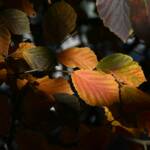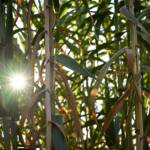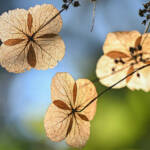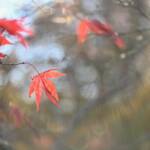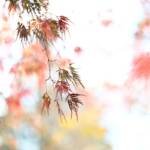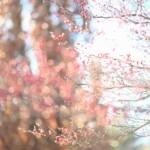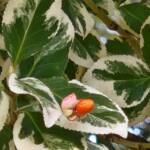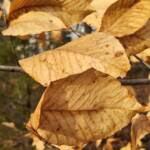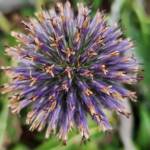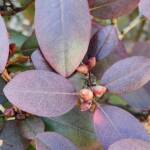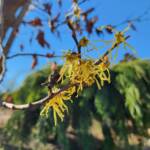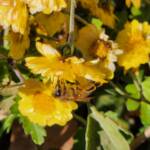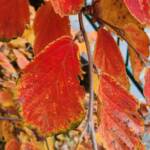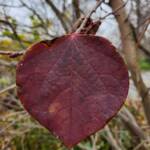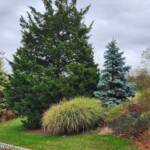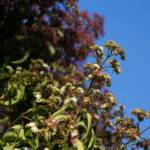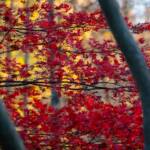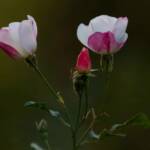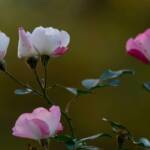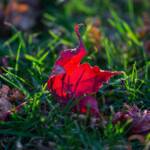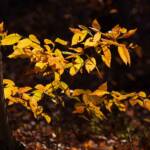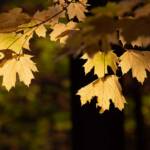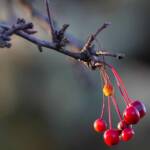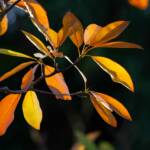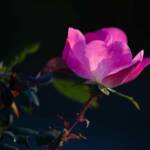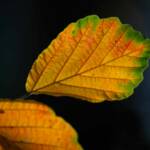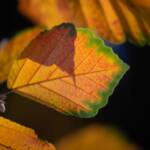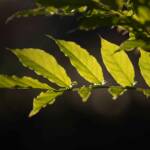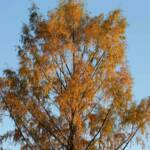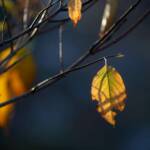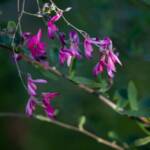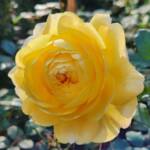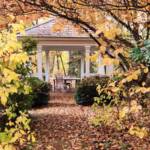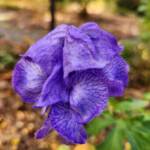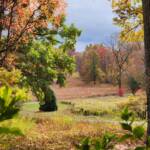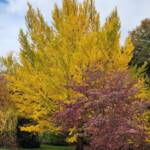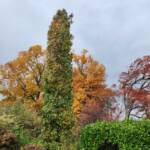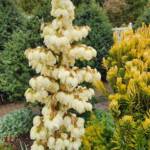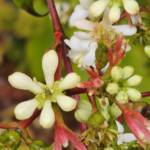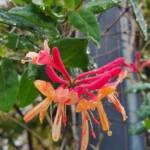Frequent contributor, Katharine Boyle, sent these nice pictures with a brief note: “Enclosed are some images from my short time at the arboretum on November 20. It was quite cold and windy, not ideal for me with my macro lens. But, it made for a few “impressionistic” images.”
This Week at the Arboretum – 11/30/22
It was a cool and cloudy day at the Arboretum. I found an interesting Echinops ritro (Globe Thistle) seed head in the bed by the Scherer Pavillion and a beautiful Euonymus fortunei cv. Variegatus (Wintercreeper Euonymus) climbing up a tree across from the Waterwise Deck; an opened fruit, nestled among the crisp green and white leaves.
A young Beech (Fagus spp) sits under larger trees next to the bus parking area, while stubbornly holding on to its browned leaves. This is a phenomenon known as marcescence, and can be seen in other trees as well, such as Oaks and Hornbeams. The thinking is that retaining leaves until spring could be a means of slowing the decomposition of the leaves (they would rot faster if on the ground) and that dropping them in spring delivers organic material at a time when it is most needed by the growing tree. Isn’t Mother Nature wonderful?
Picture credits: Margery Ennist.
This Week at the Arboretum – 11/23/22
An amazingly mild, sunny day in the low 50’s. A large clump of sweet-smelling yellow flowers (probably a Chrysanthemum variety) is still blooming in the perennial gardens and the bees are swarming over this last source of nectar for the season. The Hamamelis vernalis next to the Waterwise Deck is decked out in delicate, strappy yellow flowers and a PJM Rhododendron, also by the Waterwise Deck, is covered in deep red leaves.
Enjoy a visit soon.
Add a Link to a Post or Event
To add a link to a post or event you are working on in the editor,
First, highlight the text you want to make into a link …
Then, click the link button in the toolbar (looks like a hyphen inside parentheses).
In the dropdown, copy and paste the URL you want as the destination for the link.
Note that it must be a full URL, starting with http:// or https://, so the best way to do this is to navigate to the destination in your browser and copy (Control or Command C) the URL from the browser’s address bar. Then paste (Control or Command V) it into this dropdown.
Return to save the URL and click back in the editor. You should see the familiar underlined blue text designating a live link. After you save and preview the page, test the link to make sure it works.
This works in any text block, e. g. Headings, Paragraphs, Lists, etc.
This Week at the Arboretum – 11/16/22
The nice warm weather we’ve been enjoying has given way to colder, more seasonal weather with the possibility of a snow shower overnight. In spite of the forecast, color is still to be found on the grounds at the Arboretum. A pretty, red, heart-shaped leaf of Disanthus cercidifolius clinging to the shrub which is in the Witch Hazel family. The vibrant orange leaves of Hamamelis vernalis ‘Red Imp’ (a vernal Witch Hazel cultivar) providing a spot of color next to the Haggerty Education Center.
The fall and winter months are a great time to see different colors, textures, forms, shapes and sizes, as in the combination of a tall green female Juniperus virginiana cv. Corcorcor (Emerald Sentinel Juniper), a shorter Picea pungens cv. Splitrock (Colorado Spruce cultivar) on the right and the softly spreading leaves of a Panicum virgatum cv. Prairie Skies (Switch Grass) in front of both.
Remnants of Autumn – 11/12/22
Frequent contributor, Steve Kanan, sent these beautiful pictures of Fall’s final fling.
Thanks as always for another beautiful view of the Frelinghuysen Arboretum.
Fall at the Frelinghuysen Arboretum
Fall at The Frelinghuysen Arboretum is beautiful; the trees and shrubs have donned their autumnal colors but with the warm weather we’ve been enjoying, there are still some gorgeous flowers to be found. A yellow, sweetly-scented Rosa ‘The Poet’s Wife’ is blooming in the rose garden and an Aconitum (Monkshood or Wolf’s Bane) is blooming in the Eger Fern Garden. The Gazebo next to the Knot Garden sits amid a host of yellow foliage and fallen leaves. Enjoy a visit soon!
Picture credits: Margery Ennist.
Today at the Arboretum – 11/2/22
A quiet, overcast day at the Arboretum; the fall foliage still clinging to trees and shrubs is creating beautiful vignettes on the grounds: a long-shot of the misty meadow behind the Mansion, a Ginkgo biloba (Maidenhair Tree) in all its yellow glory and a Cornus spp (Dogwood) in full fall red, as well as a columnar Liquidambar styraciflua ‘Silhouette’ (Columnar Sweetgum ‘Silhouette’) framed by a Sugar Maple on the left and a Norway Maple on the right. Sadly, these gorgeous colors won’t last, so make plans to visit soon.
Picture credits: Margery Ennist.
Today at the Arboretum – 10/26/22
A foggy, misty, mild day, lots of rain drops glistening on leaves and dripping off flowers such as the ones on the Lonicera heckrotii ‘Goldflame’ (Goldflame Honeysuckle) blooming next to the parking lot. The Yucca recurvifolia (Curve Leaf Yucca) blooming next to the Waterwise Deck is magnificent in full bloom next to a yellow-foliaged Cephalotaxus harringtonia cv. Korean Gold (Japanese Plum Yew). Last, but not least, the small, creamy white, fragrant flowers of Heptacodium miconioides (Seven Sons Tree).
Picture credits: Margery Ennist.
FOFA Manual – Images & Galleries in Posts
Adding images or galleries to posts or pages is easy in WordPress.
The starting point is to add your images to the Media Library. This is discussed in more detail in FOFA Manual – Images and the Media Library. Pay special attention to the discussion of image sizes and standards there and elsewhere.
Once you have your pictures in the Media Library you can open your post in the editor or create a new post. I find it easiest to enter the text for the post first and then to add the images, but you could just as well add some text, then some images and so on. Take your pic
Insert a single right-adjusted image
So, assuming you have your text in the editor window and want to add a single image:
- Hover your cursor between the text paragraphs where you want to insert. A “+” sign should appear. Click it and then select Image.
- Select media Library as the source which opens it.
- Search for the image – the library is sorted by added date, so probably your image is at or near the top. Otherwise, try the text filter for file name or caption.
- Click the image, the the Select button at lower right.
- That will place a full-sized image into the editor widow.
- While that image is still selected, change the image size to Medium in the right sidebar.
- Then, change the alignment to Align Right in the image block toolbar (#2).
- You can move the image up or down on the page by clicking the arrows in the image block toolbar (#1).
- Click the link button (#3) in the toolbar and then Media File to add a link to the image so when you click it the full-sized image opens.
- Click the Publish or Update button to save your changes. Remember to click publish twice.
Repeat this process to add more images throughout the post.
Insert a photo gallery
Sometimes inserting a group of pictures, a photo gallery, is more appropriate. To do so takes three steps:
- Add your images to the Media Library.
- Create a photo gallery with the FooGallery plugin.
- Insert that gallery into your page or post.
1. Add your images to the Media Library
- Gather your images, resizing if necessary to fit under the 2 MB image size limit. A good pixel size is long edge = 2400 pixels.
- Add the images to Media Library following these directions: FOFA Manual – Images and the Media Library
- Categorize the images as “Gallery” and add captions and descriptions (this is very important — Google downgrades our search if we have pictures without the ALT or DESCRIPTION field).
2. Create a photo gallery with FooGallery
FooGallery is a WordPress plugin that speeds gallery creation. Follow these steps:
- In the dashboard, click on FooGallery, then Add New Gallery.
- Add a title to your gallery, then click the button “Add from Media Library” which then opens.
- Select all the images you want to include, then click the “Add Media” button in the bottom left.
- Your gallery is ready to save, so click “Publish” in the right sidebar.
- Now click the Shortcode further down the right sidebar. This copies that code to your clipboard which you will use in the next section, inserting the gallery into the post.
3. Insert the photo gallery into your post
Now you can either create a new post (in left sidebar Post | Add New) ir open an existing post (in left sidebar Post | All Posts then open the desired post in edit mode.
Select the place you want your gallery in the post and add a new shortcode block:
- Place your cursor where you want the gallery.
- Click the “+” button at the top to open the block add screen. Search for shortcode and then click it.
- Click in the box where it says “Write shortcode here” and then paste the shortcode from the earlier section. If you have lost it from your clipboard, you can go back to FooGalley, open the desired gallery and click the shortcode again. Be sure to save your post first by clicking switch to draft or Publish or Update at the top right. Then return to your post and paste the shortcode into its block.
And that’s it. Once you Publish or Update the post, the text and the gallery you created will appear for everyone to see.
